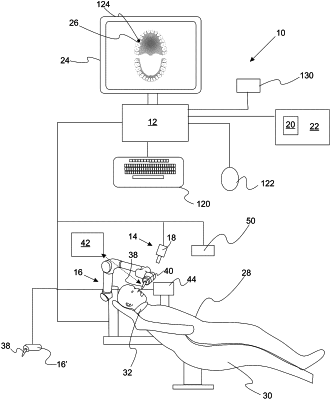| CPC A61B 34/30 (2016.02) [A61B 34/00 (2016.02); A61B 34/10 (2016.02); A61B 90/361 (2016.02); A61C 1/082 (2013.01); A61C 19/00 (2013.01); G16H 50/50 (2018.01); A61B 34/25 (2016.02); A61B 2034/102 (2016.02); A61B 2034/2048 (2016.02); A61B 2034/2059 (2016.02); A61B 2090/064 (2016.02); A61B 2090/364 (2016.02); A61B 2090/367 (2016.02); A61B 2090/373 (2016.02)] | 19 Claims |

|
1. A system for performing dental surgery on a subject, the system comprising:
a density scanner creating a voxel image of a target tooth representing a density value of a target tooth, the density value comprising a radial distance from the external surface of the target tooth;
a central processing unit having a computer memory encoded with a control program to render a three dimensional model of a target tooth from the voxel image and create an application that controls automated operation of the system, the three dimensional model including a post-surgical tooth mesh and a restoration mesh, wherein generation of the post-surgical tooth mesh and the restoration mesh incorporates a minimum material thickness, and wherein the minimum material thickness is determined by articulating a target tooth mesh with an opposing tooth mesh and subtracting a minimum thickness requirement of the target tooth from a height of the opposing tooth mesh;
an input device that receives surgical instructions from a user for providing the surgical intervention, the input device comprising a display for depicting the three dimensional model of the target tooth, the surgical instructions comprising selection of a positioning reference point corresponding to a position of a clamp, wherein the surgical instructions are received by the central processing unit; and
a robot in communication with the central processing unit, the robot including an end effector for performing dental surgery, wherein the central processing unit controls the robot to remove a region of the target tooth based on the surgical instructions, the voxel image, a motor load of the end effector, coordinates of the end effector, and a feed rate of the end effector.
|